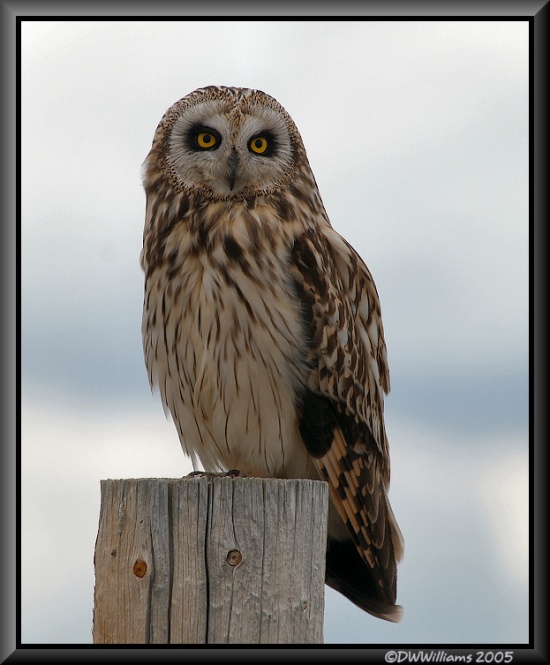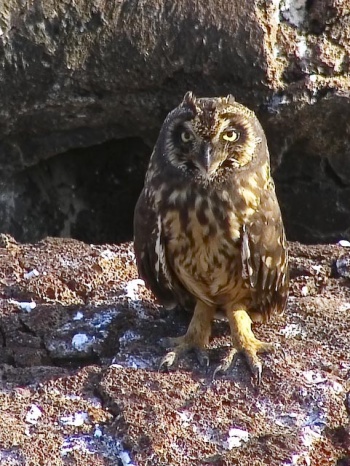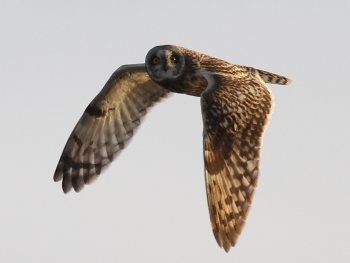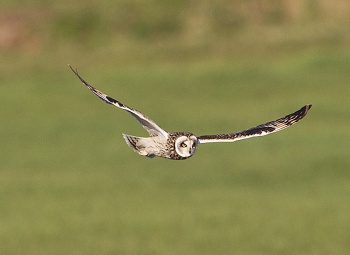Alternative name: Pueo
- Asio flammeus
Identification
L. 33-40 cm (13-15¾ in); Wing span: 95-105 cm (34½-41¼ in)
- Bright yellow eyes
- Rather plain face with dark circles around the eye
- Ears are small and often inconspicuous
- Overall cryptically patterned
- Striped underparts
- Contrast between darker throat and upper breast and lighter, more uniform lower breast and abdomen.
A medium sized owl with long wings, its flight is quite harrier like. Often seen actively hunting in daylight over open country such as moorland and savanna.
In flight shows strong black area at wrist both above and on underwing, and distinct, coarse dark barring at the tips of the primaries; between these is an area on the upper wing where the base of the primaries is unbarred rusty-yellow, in good contrast to the surrounding black.
Similar Species
It can be confused with Long-eared Owl which is normally but not always nocturnal, and is mostly found in forested areas. Long-eared has more uniform underside when perched and lack the black area around the eyes.
In flight, the wings are not quite as long and the base of the primaries contrast less sharply with the surrounding black because of narrower dark barring that is spreading into the base of the primaries and because the base of the primaries are generally darker on this species.
- Note that the Identification fields are written to fit the situation in Europe; some variation within the species is covered in the Taxonomy section.
Distribution
Widely distributed as a breeding bird in northern Europe, northern Asia, North and South America. The nominate subspecies is mainly migratory, with some southern populations more sedentary; southernmost populations of subspecies A. f. suinda (southern South America) migrates north in winter while most other subspecies are resident. Due to this migration, during the northern hemisphere winter the species is found in southern Europe, Africa (as far south as Gambia, Mali and Chad), parts of India and southern Asia. The species is completely absent from Australia, and parts of south and south-east Asia.
Taxonomy

Photo © by Alok Tewari
Gurgaon Rural, Haryana, North-west India, January-2019
There are 8[2] to 10[1] subspecies:
- A. f. flammeus -- the nominate subspecies is widely distributed breeding from Britain and Europe through Asia and America south to California and North Carolina. In Britain local in north, sporadic in south.
- A. f. sandwichensis of Hawaii, commonly referred to by its Hawaiian name "pueo", is smaller than most nominate birds.
- A. f. domingensis is a small subspecies (12% smaller than nominate) which is resident in Hispaniola, and with records from Cuba as well; this subspecies may overlap with wintering nominate birds, but in breeding season is quite isolated from other forms.
- A. f. portoricensis for the birds in Puerto Rico, which are similar to those in Hispaniola and Cuba. Some authorities treat this as a synonym of A. f. domingensis.
- A. f. bogatensis is found in South America in Colombia, Ecuador and Peru.
- A. f. palidicaudus is found in Venezuela and into The Guianas. Some authorities include this in A. f. bogatensis.
- A. f. suinda is found south of this form, in Peru, Chile, Brazil and Argentina; this is a relatively large subspecies.
- A. f. sanfordi is the subspecies found in the Falkland Islands.
- A. f. ponapensis is a subspecies found on Ponape in the Caroline Islands in the South Pacific.
- The subspecies A. f. galapogoensis deserves a species mention, as it is a small and very dark form with a distinct dark mask. König et al. calls for collection of additional information allowing testing of the hypothesis that this might be a full species.
Habitat
Breeds on heathland, in scrub among meadows, on bogs, esp. in upper tree zone in open boreal forests. Some subspecies also in dryer, open lands. In winter occur in a variety of open landscapes, often in habitat shared with Hen Harriers.
Behaviour
It quarters the ground with its wings held up at an angle and then suddenly stalls and lands on its prey, which is mostly small mammals.
Partly diurnal, often the most diurnal species of owl in much of its range.
Diet
Food mainly voles, and population density in a given area can vary considerably depending on food availability.
Breeding
Nest is a scrape on the ground.
Vocalisation
References
- Clements, J. F., T. S. Schulenberg, M. J. Iliff, S. M. Billerman, T. A. Fredericks, J. A. Gerbracht, D. Lepage, B. L. Sullivan, and C. L. Wood. 2021. The eBird/Clements checklist of Birds of the World: v2021. Downloaded from https://www.birds.cornell.edu/clementschecklist/download/
- König, C. and F. Weick 2008. Owls of the World, second edition. Christopher Helm, London. ISBN 978-0-7136-6548-2
- Alvaro Jaramillo. 2003. Birds of Chile. Princeton Field Guides. ISBN 0-691-11740-3
Recommended Citation
- BirdForum Opus contributors. (2025) Short-eared Owl. In: BirdForum, the forum for wild birds and birding. Retrieved 15 May 2025 from https://www.birdforum.net/opus/Short-eared_Owl
External Links
GSearch checked for 2020 platform.1







